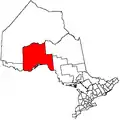Nipigon
Nipigon (/ˈnɪpɪɡən/) is a township in Thunder Bay District, Northwestern Ontario, Canada, located along the west side of the Nipigon River and south of the small Lake Helen running between Lake Nipigon and Lake Superior. Lake Nipigon is located approximately 25 kilometres (16 mi) north of Nipigon.
Nipigon | |
|---|---|
| Township of Nipigon | |
 | |
| Nickname(s): "The Lakehead" | |
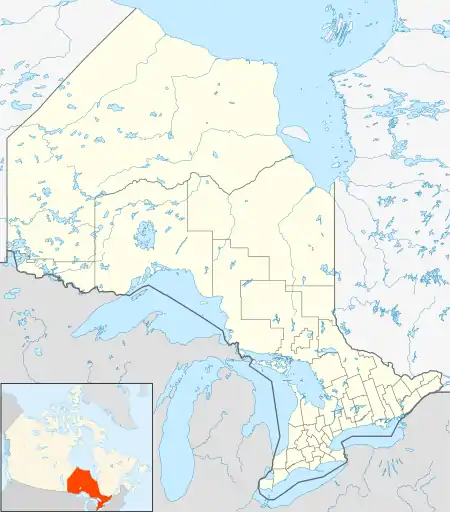 Nipigon  Nipigon | |
| Coordinates: 49°00′55″N 088°16′06″W | |
| Country | Canada |
| Province | Ontario |
| District | Thunder Bay |
| Government | |
| • Mayor | Jovani Efforg |
| • Federal riding | Thunder Bay—Superior North |
| • Prov. riding | Thunder Bay—Superior North |
| Area | |
| • Land | 109.11 km2 (42.13 sq mi) |
| Population (2016)[1] | |
| • Total | 1,642 |
| • Density | 15.0/km2 (39/sq mi) |
| Time zone | UTC−5 (EST) |
| • Summer (DST) | UTC−4 (EDT) |
| Postal Code | P0T 2J0 |
| Area code(s) | 807 |
| Website | nipigon |
Nipigon is served by several transportation corridors:
- Highway 11
- Highway 17, both part of the Trans-Canada Highway
- Canadian Pacific Railway
Geography
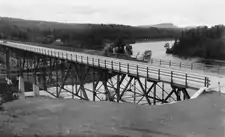
For about 15 km, Highway 11 runs within Nipigon River and a lake. Nipigon is located northeast of Thunder Bay, southwest of Geraldton and Beardmore, west of Marathon and northwest of Sault Ste. Marie. The crater on Mars named Nipigon Crater or Crater Nipigon is named after this town.
Nipigon is surrounded with pine and other varieties of forests. The power line connecting from Lake Nipigon supplies electricity to Thunder Bay and area. The other power line runs between Thunder Bay and the rest of Ontario. Timbering has been common sporadically to the north, the northwest and further north within Lake Nipigon along with parts of the southwest which formed old forest roads to the northeast and north. The municipality of Greenstone lies to the north. A manufacturing plant lies to the south. Several other unincorporated municipalities were around Nipigon. A communications tower near Nipigon broadcasts a local radio station and television channels from Thunder Bay including CKPR (TBT), CFNO and CBQT.
There are two bridges at the east end of town spanning the Nipigon River: one is a single-track railway bridge belonging to the Canadian Pacific Railway, and the other is a two-lane highway bridge constructed by the Province of Ontario. With the exception of the Canadian National Railway transcontinental rail line, the two bridges are the narrowest east-west land link in Canada's transportation system. Both Highways 11 and 17 and the Canadian Pacific Railway route all their traffic across those bridges.
The Nipigon River Bridge is a pair of two-lane cable-stayed bridges, the first of their kind in Ontario, replacing the 1937 bridge.[2] On January 10, 2016, the first bridge heaved apart but did not collapse, resulting in traffic having to reroute through the United States. However, one lane was re-opened to traffic 17 hours later.[3]
Demographics
| Year | Pop. | ±% |
|---|---|---|
| 1991 | 2,338 | — |
| 1996 | 2,210 | −5.5% |
| 2001 | 1,964 | −11.1% |
| 2006 | 1,752 | −10.8% |
| 2011 | 1,631 | −6.9% |
| 2016 | 1,642 | +0.7% |
| [4][5][1] | ||
| Canada census – Nipigon community profile | |||
|---|---|---|---|
| 2016 | 2011 | 2006 | |
| Population: | 1,642 (+0.7% from 2011) | 1,631 (-6.9% from 2006) | 1,752 (-10.8% from 2001) |
| Land area: | 109.11 km2 (42.13 sq mi) | 109.14 km2 (42.14 sq mi) | 109.14 km2 (42.14 sq mi) |
| Population density: | 15.0/km2 (39/sq mi) | 14.9/km2 (39/sq mi) | 16.1/km2 (42/sq mi) |
| Median age: | 48.6 (M: 47.9, F: 49.2) | 43.6 (M: 43.8, F: 43.4) | |
| Total private dwellings: | 804 | 823 | 837 |
| Median household income: | $57,062 | $49,163 | |
| References: 2016[6] 2011[7] 2006[8] earlier[9] | |||
Economy
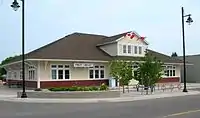
The chief industries in Nipigon are forest products, fishing, and tourism.
Nipigon is a setting off point for fishing excursions onto Lake Superior and the Nipigon River system leading up to Lake Nipigon. Fish varieties common to this area include Atlantic salmon, lake trout, speckled trout (the world's largest speckled trout was caught in the Nipigon River in 1915, weighing in at 14.5 pounds (6.6 kg)[10]), rainbow trout, walleye, northern pike, bass, and perch.
Mill fire
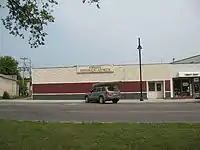
On February 6, 2007, a devastating fire ripped through Multiply Forest Products, burning the mill to the ground.[11] The mill was the main employer in the town. Less than a month earlier workers at the mill had purchased it from Columbia Forest Products of Portland, Oregon. At the time of the sale, a $4-million modernization plan for the mill was also announced. More than 100 people were employed at the plant, which produced hardwood underlayment for vinyl, plywood and laminate flooring.[12]
Notable people from Nipigon
Nipigon was the birthplace of two time world curling champion Allan A. "Al" (the Iceman) Hackner. Hackner won The Brier in 1982 and 1985.
See also
References
- "Census Profile, 2016 Census: Nipigon, Township". Statistics Canada. Retrieved July 12, 2019.
- "Nipigon River Bridge Construction Updates & Progress". Nipigon River Bridge Project. Retrieved January 10, 2016.
- Husser, Amy (January 10, 2016). "Ontario's Nipigon River bridge fails, severing Trans-Canada Highway". CBC News. Canadian Broadcasting Corporation. Retrieved January 10, 2016.
- Statistics Canada: 1996, 2001, 2006, 2011 census
- "Nipigon census profile". 2011 Census of Population. Statistics Canada. Retrieved 2012-03-29.
- "2016 Community Profiles". 2016 Canadian Census. Statistics Canada. February 21, 2017. Retrieved 2019-07-12.
- "2011 Community Profiles". 2011 Canadian Census. Statistics Canada. July 5, 2013. Retrieved 2012-03-29.
- "2006 Community Profiles". 2006 Canadian Census. Statistics Canada. March 30, 2011. Retrieved 2011-04-21.
- "2001 Community Profiles". 2001 Canadian Census. Statistics Canada. February 17, 2012.
- Dr. JW Cook's World Record Brook Trout Was Caught in 1915
- Toronto Star, February 07, 2007, "Nipigon mill fire a `devastating' loss"
- Toronto Star, February 18, 2007, Leslie Scrivener, "A town called hope"
External links
| Wikimedia Commons has media related to Nipigon. |
| Wikivoyage has a travel guide for Nipigon. |
- Township of Nipigon
- Paddle to the Sea Park (opened 2016, see Paddle-to-the-Sea)
